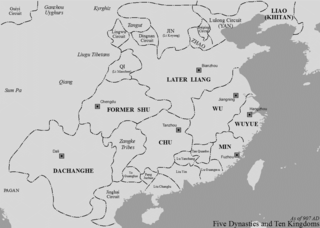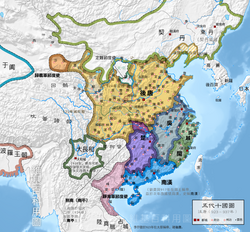
The Zizhi Tongjian (1084) is a chronicle published during the Northern Song dynasty (960–1127) that provides a record of Chinese history from 403 BC to 959 AD, covering 16 dynasties and spanning almost 1400 years. The main text is arranged into 294 scrolls, each equivalent to a chapter—totaling around 3 million Chinese characters.

The Northern Han was a dynastic state of China and one of the Ten Kingdoms during the Five Dynasties and Ten Kingdoms period. It was founded by Liu Min as a continuation of the Later Han dynasty founded by his brother Liu Zhiyuan. The Northern Han lasted from 951 to 979, when it was conquered by the Northern Song dynasty.
For most of its history, China was organized into various dynastic states under the rule of hereditary monarchs. Beginning with the establishment of dynastic rule by Yu the Great c. 2070 BC, and ending with the abdication of the Xuantong Emperor in AD 1912, Chinese historiography came to organize itself around the succession of monarchical dynasties. Besides those established by the dominant Han ethnic group or its spiritual Huaxia predecessors, dynasties throughout Chinese history were also founded by non-Han peoples.

Ouyang Xiu, courtesy name Yongshu, also known by his art names Zuiweng (醉翁) and Liu Yi Jushi (六一居士), was a Chinese historian, calligrapher, epigrapher, essayist, poet, and politician of the Song dynasty. He was a renowned writer among his contemporaries and is considered the central figure of the Eight Masters of the Tang and Song. He revived the Classical Prose Movement and promoted it in imperial examinations, paving the way for future masters like Su Shi and Su Zhe.

Liang, known in historiography as the Later Liang or the Zhu Liang, was an imperial dynasty of China and the first of the Five Dynasties during the Five Dynasties and Ten Kingdoms period. It was founded by Zhu Wen, after he forced the last emperor of the Tang dynasty to abdicate in his favour. The Later Liang would last until 923 when it was destroyed by the Later Tang dynasty.

Southern Han (Chinese: 南漢; pinyin: Nán Hàn; Jyutping: Naam4 Hon3; 917–971), officially Han (Chinese: 漢), originally Yue (Chinese: 越), was a dynastic state of China and one of the Ten Kingdoms that existed during the Five Dynasties and Ten Kingdoms period. It was located on China's southern coast, controlling modern Guangdong and Guangxi. The dynasty greatly expanded its capital Xingwang Fu (Chinese: 興王府; pinyin: Xìngwáng Fǔ; Jyutping: Hing1wong4 Fu2, present-day Guangzhou). It attempted but failed to annex the autonomous polity of Jinghai, which was controlled by the Vietnamese.

Jingnan, also known as Nanping and Northern Chu (北楚) in historiography, was a dynastic state of China and one of the Ten Kingdoms during the Five Dynasties and Ten Kingdoms period. Lasting from 924 to 963, it was located in south-central China.

Chu, known in historiography as Ma Chu (馬楚) or Southern Chu (南楚), was a dynastic state of China that existed from 907 to 951. It is counted as one of the Ten Kingdoms during the Five Dynasties and Ten Kingdoms period of Chinese history.

Shu, referred to as Later Shu and Meng Shu in historiography, was a dynastic state of China and one of the Ten Kingdoms during the Five Dynasties and Ten Kingdoms period. It was located in present-day Sichuan with its capital in Chengdu and lasted from 934 to 965.

Abaoji, posthumously known by his temple name as the Emperor Taizu of Liao, was a Khitan leader and the founding emperor of the Liao dynasty of China, ruling from 916 to 926. He had a sinicised name, Yelü Yi; some sources suggest that Abaoji's family name, Yelü, was adopted during his lifetime, although there is no consensus amongst historians on this point.

Great Shu, known in historiography as the Former Shu or occasionally Wang Shu (王蜀), was a dynastic state of China and one of the Ten Kingdoms during the Five Dynasties and Ten Kingdoms period. It existed from 907 to 925 CE.

Jin, known as the Later Jìn or the Shi Jin (石晉) in historiography, was an imperial dynasty of China and the third of the Five Dynasties during the Five Dynasties and Ten Kingdoms period. It was founded by Shi Jingtang with aid from the Liao dynasty, which assumed suzerainty over the Later Jin. After Later Jin's second ruler, Shi Chonggui, fell out with the Liao dynasty, the Liao invaded in 946 and in 947, annihilated the Later Jin and annexed its former territories.

The Sixteen Prefectures of Yanyun comprise a historical region in northern China along the Great Wall in present-day Beijing, Tianjin, and part of northern Hebei and Shanxi. It was a site of constant military and political conflict between various dynasties from the end of the Tang dynasty until the establishment of the Yuan dynasty.

Han, known as the Later Han in historiography, was a short-lived imperial dynasty of China that existed from 947 to 951. It was the fourth of the Five Dynasties during the Five Dynasties and Ten Kingdoms period in Chinese history, and the third consecutive Shatuo-led Chinese dynasty, although other sources indicate that the Later Han emperors claimed patrilineal Han ancestry. It was among the shortest-lived of all Chinese regimes, lasting for slightly under four years before it was overthrown by a rebellion that resulted in the founding of the Later Zhou dynasty. Remnants of the Later Han then founded the Northern Han dynasty.

Zhou, known as the Later Zhou in historiography, was a short-lived Chinese imperial dynasty and the last of the Five Dynasties that controlled most of northern China during the Five Dynasties and Ten Kingdoms period. Founded by Guo Wei, it was preceded by the Later Han dynasty and succeeded by the Northern Song dynasty.

Yan, sometimes known in historiography as Jie Yan (桀燕), was a short-lived monarchical state in the vicinity of present-day Beijing at the beginning of the Five Dynasties and Ten Kingdoms period. Yan, established by Liu Shouguang in 911, only lasted for two years before its destruction by Li Cunxu of the Former Jin dynasty.

Imperial China: 900–1800 is a history book written by Frederick W. Mote, Professor of Chinese History and Civilization, Emeritus, at Princeton University. The book was published in 1999 by Harvard University Press.

The Shatuo, or the Shatuo Turks were a Turkic tribe that heavily influenced northern Chinese politics from the late ninth century through the tenth century. They are noted for founding three, Later Tang, Later Jin, and Later Han, of the five dynasties and one, Northern Han, of the ten kingdoms during the Five Dynasties and Ten Kingdoms period. The Northern Han would later be conquered by the Song dynasty. Sometime before the 12th century, the Shatuo disappeared as a distinct ethnic group, many of them having become acculturated and assimilating into the general population around them.

Jin, also known as Hedong (河東) and Former Jin (前晉) in Chinese historiography, was a dynastic state of China and the predecessor of the Later Tang dynasty. Its princely rulers were the ethnic Shatuo warlords Li Keyong and Li Cunxu. Although the Five Dynasties period began only in 907, Li Keyong's territory which centered around modern Shanxi can be referred to as Jin as early as 896, when he was officially created the Prince of Jin by the failing and powerless Tang dynasty court, or even as early as 883, when he was created the jiedushi military governor of Hedong Circuit, which controlled more or less the same territory.














